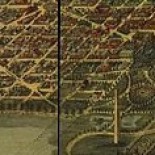(Repeat) Washington Welcomes the Automobile: 120-year Romance — Part II, Adoption and Regulations
originally PUBLISHED: JULY 24TH, 2019
By Matthew B. Gilmore*
Complete column here: http://intowner.com/2019/07/24/washington-welcomes-the-automobile-120-year-romance-part-ii-adoption-and-regulations/
In 1900 there were approximately 11,000 horses in Washington, and 40 horse-shoers, and 66 commercial stables. This required a big government investment in street cleaning — $76,000 annually — which paid for 208 men, 20 horses, and 9 wagons. [1] The men worked between 17 and 25 days per month year-round.
The rapid adoption of mechanical horsepower brought some welcome changes to Washington streets. Washington was well-known for its well-paved streets, with over three million square yards of asphalt or asphalt block pavements — ranking fifth in the nation in 1905. (Another million square feet was graveled, indicative of the large proportion of the District being still-rural.) [2]

Map of the city of Washington shows streets cleaned by hand or machine, sprinkled unimproved streets, and public dumps. “Fiscal year 1901.” The daily hand cleaning area (in pink) covered much of downtown Washington from New Jersey Ave. on the east to New Hampshire Ave. on the west, R St. on the north, to B St. on the south. photo–Library of Congress, Geography and Maps Div.
Local Enthusiasts
There were some noted automobile enthusiasts in early 20th century Washington, Larz and Isabel Anderson in particular. Their Massachusetts Avenue, NW grand mansion is now the headquarters of the Society of the Cincinnati; the carriage house of their Brookline, Massachusetts home is now the Larz Anderson Auto Museum. The Anderson’s first motor vehicle, an 1899 Winton four-horsepower Runabout, is still on display there. It cost $1,000.
The Peter family of Tudor Place in Georgetown did not adopt quite as early. Armistead Peter inherited the estate in 1911 from his grandmother. Peter purchased first a 1913 Pierce-Arrow 48-B2 Vestibule Suburban and had a garage built, and in a note from October 15, 1913, wrote, “the auto arrived yesterday, It is all that could be desired.” [3]
The Peters purchased four more Pierce-Arrows: a 1914 48-B2 Touring Car, a 1916 38-C4 Two Passenger Runabout, a 1919 48-B5 Roadster, and a 1920 Town Brougham. That 1919 48-B5 Roadster (purchased for Armistead Peter 3rd by his parents), is still housed in the Tudor Place garage, and is one of the few vintage automobiles on display in Washington.
Automobiles took the place of horses in “automobile stables” in Washington but soon they would get dedicated structures. One of the first purpose-built “garages” in Washington is located at 2201 Massachusetts Avenue NW (at Massachusetts, Florida, and 22nd), and, entered through the side alley, forms part of the Miller House, constructed in 1900. The house, designed by Paul J. Pelz, of Library of Congress fame, is now a condominium known as Argyle Terrace. The garage was used for a time by Olga Hirshhorn to house her art collection. Nearby Alice Pike Barney included a garage in her new home at 2306 Massachusetts Avenue on Sheridan Circle.
[SNIP] — Complete column here: http://intowner.com/2019/07/24/washington-welcomes-the-automobile-120-year-romance-part-ii-adoption-and-regulations/
Government Reaction and Regulations
How should the government respond to these new additions to the roads? Horse-drawn vehicles existed since time immemorial, streetcars since the 1860s, bicycles since the 1880s. How would these new horseless carriages be integrated?
The Washington Post reported on November 2, 1899 that the attorney for Locomobile Company of America inquired of the District commissioners what kind of permit would be needed to operate a Stanley Locomobile. The Stanley Locomobile (or Stanley Steamer) being a steam-driven vehicle, it was suggested that a third- or fourth-class engineer’s license be required. Quite a barrier to wide adoption. Speed would be limited to that of bicycles — 12 miles per hour within the city and 15 outside. As 1899 closed, the commissioners did direct that the owners of steam-powered automobiles would need to take an exam for a license to operate the vehicle and renew it annually. Also, traffic speed regulations were amended to include horseless vehicles — limited to the same speeds as bicycles.
Complete column here: http://intowner.com/2019/07/24/washington-welcomes-the-automobile-120-year-romance-part-ii-adoption-and-regulations/
